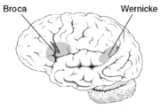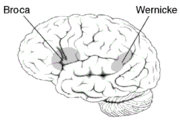
Postmortem studies
Encyclopedia
Postmortem studies are a neurobiological research method in which the brain of a patient, usually the subject of a longitudinal study
, with some sort of phenomenological affliction (i.e. cannot speak, trouble moving left side of body, Alzheimer’s, etc.) is examined after death. The irregularities, damage, or other cerebral anomalies observed in the brain are attributed with whatever ailment the patient was afflicted with in life. With repeated studies a more exact correlation can be ascertained.
it was one of the few ways to study the relation between behavior and the brain.

used postmortem studies to link a specific area of the brain with speech production.
His research started when he noticed that a patient with an aphasic stroke had lesions in the left hemisphere of his brain. His research continued and his theory held up overtime.
Most notable of his research subjects was Tan (named for the only syllable he could utter). Tan had lesions in his brain caused by syphilis. This lesion was determined to cover the area of the brain important for speech production.
The area of the brain that Broca identified is now known as Broca's area
and damage to this section of the brain can lead to Broca's aphasia.
also used postmortem studies to link a specific area of the brain with speech production. However his research focused more on patients who could speak, but whose speech made little sense and/or has trouble understanding spoken words or sentences.
His research in language comprehension and the brain also found it to be localized in the left hemisphere, but in another section. This area is now known as Wernicke's area
and damage to this section can lead to Wernicke's aphasia.
The very thing that makes it such a great research method is its greatest weakness. The researcher is studying a human and his brain. However, getting a hold of person’s brain, even from one who is a subject of a longitudinal study, can be difficult. Furthermore, the rarity of the affliction studied may also affect the scarcity of the needed brain.
Also, brain damage is what being studied. It is possible that there might be too much damage to pinpoint any specific area of the brain as being responsible.
Longitudinal study
A longitudinal study is a correlational research study that involves repeated observations of the same variables over long periods of time — often many decades. It is a type of observational study. Longitudinal studies are often used in psychology to study developmental trends across the...
, with some sort of phenomenological affliction (i.e. cannot speak, trouble moving left side of body, Alzheimer’s, etc.) is examined after death. The irregularities, damage, or other cerebral anomalies observed in the brain are attributed with whatever ailment the patient was afflicted with in life. With repeated studies a more exact correlation can be ascertained.
Background
Postmortem studies have been used to further the understanding of the brain for centuries. Before the time of the MRI, CAT Scan, or X-rayX-ray
X-radiation is a form of electromagnetic radiation. X-rays have a wavelength in the range of 0.01 to 10 nanometers, corresponding to frequencies in the range 30 petahertz to 30 exahertz and energies in the range 120 eV to 120 keV. They are shorter in wavelength than UV rays and longer than gamma...
it was one of the few ways to study the relation between behavior and the brain.

Broca
Paul BrocaPaul Broca
Pierre Paul Broca was a French physician, surgeon, anatomist, and anthropologist. He was born in Sainte-Foy-la-Grande, Gironde. He is best known for his research on Broca's area, a region of the frontal lobe that has been named after him. Broca’s Area is responsible for articulated language...
used postmortem studies to link a specific area of the brain with speech production.
His research started when he noticed that a patient with an aphasic stroke had lesions in the left hemisphere of his brain. His research continued and his theory held up overtime.
Most notable of his research subjects was Tan (named for the only syllable he could utter). Tan had lesions in his brain caused by syphilis. This lesion was determined to cover the area of the brain important for speech production.
The area of the brain that Broca identified is now known as Broca's area
Broca's area
Broca's area is a region of the hominid brain with functions linked to speech production.The production of language has been linked to the Broca’s area since Pierre Paul Broca reported impairments in two patients. They had lost the ability to speak after injury to the posterior inferior frontal...
and damage to this section of the brain can lead to Broca's aphasia.
Wernicke
Karl WernickeKarl Wernicke
Carl Wernicke was a German physician, anatomist, psychiatrist and neuropathologist. He earned his medical degree at the University of Breslau...
also used postmortem studies to link a specific area of the brain with speech production. However his research focused more on patients who could speak, but whose speech made little sense and/or has trouble understanding spoken words or sentences.
His research in language comprehension and the brain also found it to be localized in the left hemisphere, but in another section. This area is now known as Wernicke's area
Wernicke's area
Wernicke's area is one of the two parts of the cerebral cortex linked since the late nineteenth century to speech . It is involved in the understanding of written and spoken language...
and damage to this section can lead to Wernicke's aphasia.
Limitations
While postmortem studies can be very useful in linking the brain and behavior it still has its limitations.The very thing that makes it such a great research method is its greatest weakness. The researcher is studying a human and his brain. However, getting a hold of person’s brain, even from one who is a subject of a longitudinal study, can be difficult. Furthermore, the rarity of the affliction studied may also affect the scarcity of the needed brain.
Also, brain damage is what being studied. It is possible that there might be too much damage to pinpoint any specific area of the brain as being responsible.

